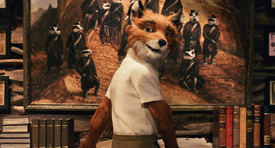
Fantastic Mr. Fox presents its storyline with retro stop-motion animation.
Fantastic Mr. Fox delivers few surprises, a lot of style, plenty of musical montages and a few too many deliberate pauses in the dialogue. But in the end, it really is OK, and at times it is great.
Independent film auteur Wes Anderson (The Darjeeling Limited) directed the movie — hitting theaters today — and brought all his trademarks with him. He uses retro stop-motion animation technology to tell Roald Dahl’s story of Mr. Fox’s struggle to elevate his family’s standing among the community of forest animals while fighting against the destructive force that is the Boggis, Bunce and Beans farming corporation
In doing so, Anderson has created another story about an eccentric and dysfunctional family in turmoil. It will win no converts from Anderson detractors, but all others should be thoroughly entertained by this visually stunning film.
Although the film uses a lot of visual gags for the benefit of younger viewers, like silly roaring animals, the dramatic conflict here is geared toward a mature audience. Fantastic Mr. Fox is like The Royal Tenenbaums made for children. The marriage of Mr. and Mrs. Fox, played by George Clooney (The Men Who Stare At Goats) and Meryl Streep (Julie & Julia), respectively, is under a great deal of strain following the move into a lavish tree.
Meanwhile, they must deal with the tension between their son Ash (Jason Schwartzman, Bored to Death) and his visiting super-athletic cousin (Eric Anderson, The Life Aquatic with Steve Zissou) while his own father fights pneumonia. Ash struggles to find a place in his high school (most characters call him “different”) while his cousin shoots to popularity and sports stardom. Mr. Fox himself is distracted by the nearby mega-farm responsible for reawakening his kleptomaniac nature to steal chickens and cider.
It is obvious before going into Fantastic Mr. Fox that the film will be visually remarkable because of the technique and Anderson’s prior strength in that area, but stop-motion animation is used as more than just a gimmick to create a likeable and believable world.
It’s a very organic-looking movie — antithetical to CGI films. Characters have a little hitch in their step, the fur on the animals is bristly, and the faces especially are cartoonish. It all works toward creating a unique world of wilderness and industry at odds.
Certainly the movie is somewhat trendy with its WALL-E-ish environmental message, and it definitely falls into the “almost indie” category with its big budget and retro soundtrack. But Fantastic Mr. Fox truly is a well-crafted and heartfelt film. Few filmmakers can be as affecting and entertaining while depicting the subtle tensions of family life as Anderson.
Structurally, you could say Fantastic Mr. Fox suffers “typical” Anderson-esque faults. Even as a “plot-driven” film, it finds a way to make every dynamic dramatic exchange static. Certain scenes are cheaply manipulated by Anderson’s trademark exaggerated close-ups of two characters, switching points of view several times to flag a scene as meaningful in the most obvious, self-deprecating way. It’s just irritating at times to halt the action for some irony, even with good intentions, even if it only happens a few times.
The rest of the film feels so genuine. Whether this is a big step forward or just a big “re-packaging” of Anderson’s familiar tropes, Fantastic Mr. Fox is an achievement for Anderson, probably his best film since Rushmore. In roughly 90 minutes, the film gives the children’s story all the complexity it can handle, making an environmentally conscious puppet film about serious issues — including class, family, sexual and political struggles — fun. Once again, Anderson makes pop art something cool.
diversions@umdbk.com
RATING: 4 stars out of 5



